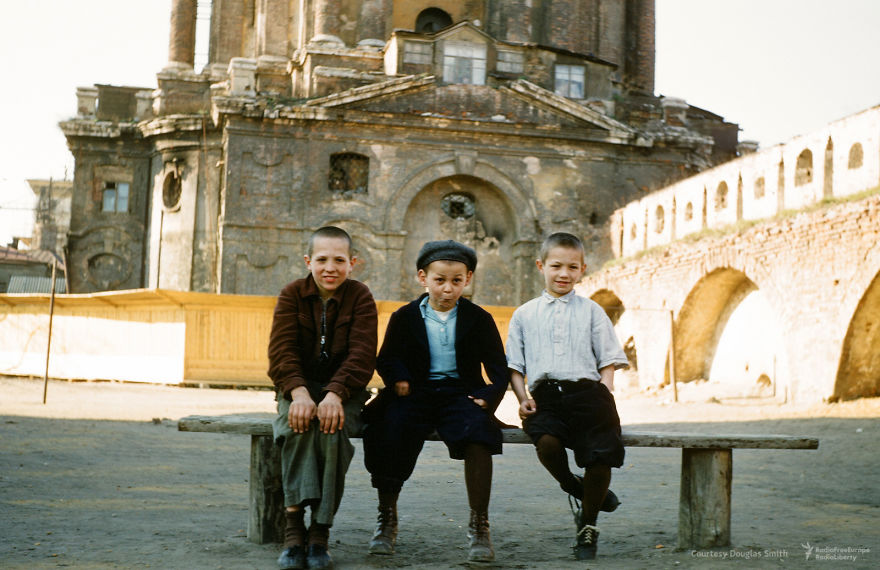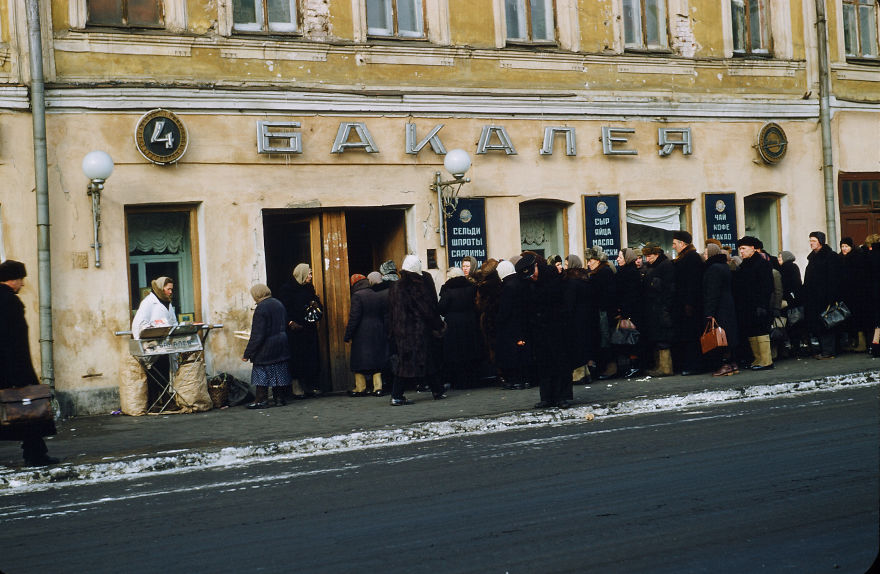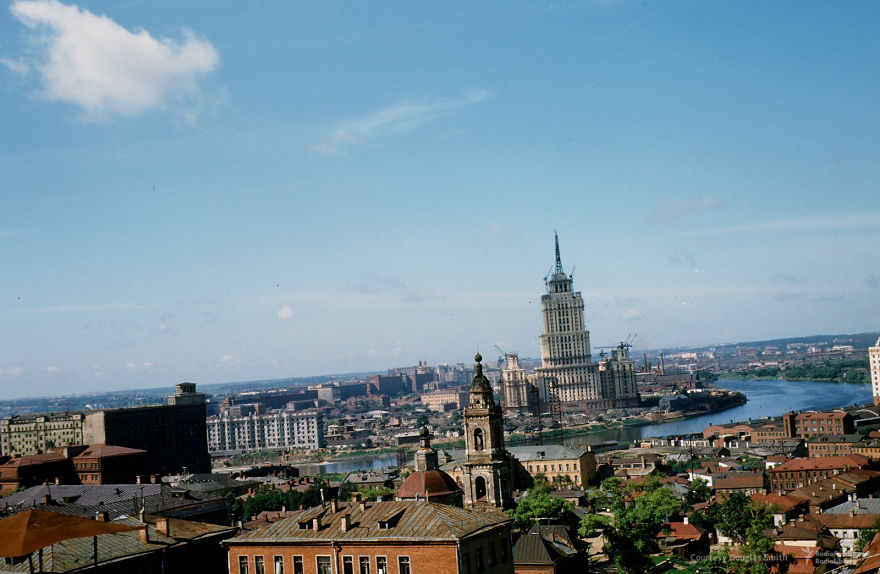
170Kviews
Never-Seen-Before Pics Of Stalin-Era USSR By US “Spy” Who Got Deported
As the USSR was busy rebuilding after World War II, an American Martin Manhoff landed in Moscow with a suitcase full of the latest photography equipment - and the skills to use it. Martin travelled throughout Russia by rail and was often accompanied by his wife Jan who recorded their memories in writing.
In 1954, two years after arriving, Martin Manhoff was expelled from the USSR for “spying”. After his expulsion to the US, the images Manhoff made lay hidden in a cupboard for more than 60 years. This year, after Manhoff's death, these crisp, colourful slides of Soviet life were re-discovered by a historian Douglas Smith.
This post may include affiliate links.
A Night Shot Of Moscow
That's the newly-constructed Moscow State University glowing on the horizon.
after watching all of your beautiful photos do you still thinking of the USSR like great Satan? Russia is wonderfull place but no westerner could understand ordinarz russian and russian soul - unless he lived with russians for at least 5--6 years..
Schoolgirls At Kolomenskoye, A Former Royal Estate In The South Of Moscow
Any of these girls alive today would now be in their 70s.
A Market In Crimea, A Few Years Before The Peninsula Was “Gifted” To Ukraine By Stalin’s Successor
Jan wrote that the peninsula "had always been a resort area, and now when the happy workers get their holidays, the top ones get to come here."
A Street In Central Kiev, Ukraine
Flooded Streets In Kiev
Jan described Ukraine as "a cleaner, more individual part of the Soviet Union... this area has certainly seen and known more than just Soviet rule."
I love the automobiles!! If that's considered a "flood", can you imagine if any of them were alive today in any of the "flooded" states!!
Babushka Dealings, Snapped Out Of The Window Of A Train
Jan said the train trips gave the Manhoffs their only chance to communicate with ordinary Russians "but here natural precaution prohibits anything but superficial talk."
You still can buy a lot of things on the platform straight from your train. Usual are apples, smoked fish, vareniks and small pies with filling
A Rural Town Snapped From A Passing Train
As well as shooting images of city life, Martin, often accompanied by his wife Jan, travelled throughout Russia by rail. This image is one of several showing small town life far from Moscow.
A Parade Under The Walls Of The Kremlin
When historian Douglas Smith discovered the images, he immediately realised he'd stumbled onto a rare treasure.
Kids Goofing For Martin's Camera In Novospassky Monastery
Ostankino Palace, In The North Of Moscow
In Soviet days, many estates and palaces of the aristocracy were opened up as public parks.
Street Scene On Pushkin Square, Looking Down Tverskaya Street Towards The Towers Of The Kremlin
A Queue Outside A Food Store In Moscow
A Murky-Looking Pool In An Unknown Location
Manhoff shot with 35mm Kodak and Agfa colour slide film. The technology was cutting edge in the US at the time, and would have been virtually unheard of inside the USSR.
They always put tons of chlorine in those pools... Was the same in East Germany...
A Rare Color Image Of Stalin's Funeral, In 1953, Snapped From The Window Of The Old US Embassy
Manhoff's job in Russia was as an assistant army attache at the embassy.
Novospassky Monastery In Moscow
Under Soviet rule religion was heavily suppressed, and many churches were either destroyed or put to use as humble storage houses.
Beautiful architecture that I'm happy to know has been restored to its original beauty and its original meaning...
Stalin’s Coffin Rolling Towards Red Square
The pale spot on the coffin is a kind of clear plastic or glass bubble over his face.
Window Shoppers In Moscow
Jan's first impressions of the city's shopping scene were scathing: "Nothing quite fits, the people as well as the furnishings. And nothing that is sold seems new, it all looks second-hand."
Chicks Chilling With Books In Moscow’s Novodevichy Convent
The Central Telegraph Building In Moscow
A Woman Snapped From The Train
The only time the Manhoffs were permitted to leave the train during their journeys was during long stops at stations en route, though even then they were required to stay on the platform.
It looks like the young lady is carrying a bucket? Maybe water? For survival...
“Shop No. 20” In Moscow, Advertising Various Fish & Meat
In the same letter Jan commented on the result of the 1917 "workers' revolution" which overthrew Russia's monarchy and capitalist system: "probably no picture of the 'revolution' is clearer, the workers have taken over and they do not yet quite how to handle it all, but there's noone else."
I really need to read "genuine" history books bc I'm not sure who or what is even factual...
Cruising In Convoy Towards The Trinity Lavra Of St. Sergius, A Couple Hours Out Of Moscow
A Card Player Looking Like He’s About To Slap Down A Flush In Kuskovo
The country estate in Moscow was owned by the Sheremetev family before the Russian revolution.
Farm Workers Watching The Manhoffs' Train Rolling Past
The New York Times reported on one of the Manhoffs’ trips deep into Siberia, claiming “Americans have never traveled to this remote area before.”
A Truck Rumbles Past The US Embassy In Moscow
Two of the men sport freshly-shaved heads.
this is an excellent photograph! The camera moves at the same speed as the truck
In One Small Town The Americans Caused A Commotion By Walking Into A Restaurant
After a local man welcomed the unexpected foreigners by firing up an accordian, Jan writes "he played well and to everyone's pleasure. One Russian bought him a bottle of beer, and we donated a bottle. Then, it happened. The manager... walked in and told everyone that the cafe was closed. Everyone with a great deal of chatter wondered why and many "pochomoos" [Russian for 'why'] were voiced. Someone asked the accordian player why and he said 'I don't know, it's the first time in my life.' Then he very amusingly said 'well, I'll play you a march', and to the tune of Russian marches we vacated."
Looks like the Alberta Badlands. No wonder so many Russians emigrated there before the war.
A Woman Poses For Martin On Petrovka Street In Moscow
Despite brief encounters like this, the Manhoffs were unable to scratch beneath the surface of Soviet life at a time when mingling with foreigners could land Russians in real trouble. Jan wrote “we’ve never been inside a Russian home, nor can ever expect to be.”
Lovely smile. She looks like a nice person. I think she would invite them for a cup of tea if she could. But she probably couldn't... it is wrong and sad. I am really glad that nowadays in my country I can offer tea to anybody... fearless... but people forget easily. And some things shouldn't be forgotten. We can learn from them.
A Public Bus And Several Cars Trapped In A Flood Caused By Summer Rains In Kiev, Ukraine
A Parade In Central Moscow A Few Steps From The Old US Embassy
The sign on left welcomes “Brothers from the Chinese Republic”.
A Policeman, Probably Snapped From The Top Of The US Embassy In Moscow
Jan wrote that the police in Moscow were "so stationed as to never be out of sight of the next one." Under Stalin's rule the USSR was a police state in which millions of people accused of opposition to the totalitarian regime were either killed, or sent to labour camps in Siberia.
At that time they were not police officers, they were called militsiya
A Child Walks Through A Run-Down Street In Moscow Near The Moskva River
Rural Homesteads Snapped From The Train
The final train adventure Martin Manhoff took ended the couple's time in the USSR. On a summer trip through Siberia in 1953 he and three colleagues were accused of illegally photographing airfields and oil dumps. The four were branded as spies and hastily evicted from the country.
A Cinema In Central Moscow Advertising The 1953 Film “Lights On The River”
The whole film is on youtube - look up: "Огни на реке."
Thank you for sharing where we may find it to watch for ourselves...
Russian Officials Are Photographed From A Window Above The Street In Murmansk
A View From The Roof Of The 'New' US Embassy
The Hotel Ukraine skyscraper is under construction across the river.
Flowers, Dancing, And North Korean Flags At A Parade In Moscow
Smith told Radio Free Europe/Radio Liberty "Manhoff captured this everyday quality... It gives a human quality that is missing from any other depiction [of life in the USSR in the 1950s.]"
A Horse Clops Past The Kremlin, As Seen From The Entrance To The Old US Embassy
A Woman Collecting Water In A Bucket In The Russian Countryside And Heading Back To A Humble Log Cabin
I've spoken with Russians who lived through the Soviet days. The shelves in stores were bare, but if you went into people's homes they had closets full of goods. One guy called it "A Soviet miracle." If you could buy something, you'd purchase it whether you needed it or not, because you never knew if it would be available when you did need it. That kind of
It's quite intriguing looking at these pictures. They make the mind wander and you start wondering how those people's lives were.
it's life in prohibition in isolation. when nothing is known about life in the world.
Being born in a postcomunist country i only caught a glimpse of life as it was but even as a kid you could sense a predominant sense of fear and lack of freedom. Life was grey because you were always reminded you cant do what you want with it.
Further insight is a treasure. My heart is saddened for all who have such well-deserved pride in their homeland of Russia. Leaders have plundered their country and continue to do so.
Joke about the state terror in the Stalin era: In the time of Stalin's mass purges, a knock at the door woke a family in the middle of night. All family members, shaking in terror, jumped up. "Take all you can carry with you, and get out at once," a voice sounded. "But, for God's sake, don't panic! It's me, your neighbour. It is nothing serious, just our house is on fire."
There is a lot of propaganda going both ways. I see a lot of comments on photos saying "that looks nice" or "those people don't even know how oppressed they were" - I lived in Soviet Russia. It was not always easy, no. And you couldn't go about screaming that you loved Jesus. But we never lacked food. Sure there were lines, but I don't remember them being longer than ones I stand in now after work in NYC. Was there a lack of blue jeans? Yes. But there were other denim products. Pioneers were honestly less intense than boy/Girl Scouts. We had to do community service like clean parks and plant trees. But we certainly never had to go around begging our friends and family for money. Was there harshness to the regime? Yes. Many of my family were sent away to Siberia. But the other side of my family was shot by nazis on site. And people continued on. I don't know how it was like in the 50s and 60s but in the 80s and 90s it was basically the same grind as here in the USA
I wonder how he managed to get these images out of Russia? They are views of the outside--life for the average Russian does not look as oppressive as it must have been--the captions say it all. They must have been terrified for their lives, for saying the wrong thing.
I've spoken with Russians who lived through the Soviet days. The shelves in stores were bare, but if you went into people's homes they had closets full of goods. One guy called it "A Soviet miracle." If you could buy something, you'd purchase it whether you needed it or not, because you never knew if it would be available when you did need it. That kind of
It's quite intriguing looking at these pictures. They make the mind wander and you start wondering how those people's lives were.
it's life in prohibition in isolation. when nothing is known about life in the world.
Being born in a postcomunist country i only caught a glimpse of life as it was but even as a kid you could sense a predominant sense of fear and lack of freedom. Life was grey because you were always reminded you cant do what you want with it.
Further insight is a treasure. My heart is saddened for all who have such well-deserved pride in their homeland of Russia. Leaders have plundered their country and continue to do so.
Joke about the state terror in the Stalin era: In the time of Stalin's mass purges, a knock at the door woke a family in the middle of night. All family members, shaking in terror, jumped up. "Take all you can carry with you, and get out at once," a voice sounded. "But, for God's sake, don't panic! It's me, your neighbour. It is nothing serious, just our house is on fire."
There is a lot of propaganda going both ways. I see a lot of comments on photos saying "that looks nice" or "those people don't even know how oppressed they were" - I lived in Soviet Russia. It was not always easy, no. And you couldn't go about screaming that you loved Jesus. But we never lacked food. Sure there were lines, but I don't remember them being longer than ones I stand in now after work in NYC. Was there a lack of blue jeans? Yes. But there were other denim products. Pioneers were honestly less intense than boy/Girl Scouts. We had to do community service like clean parks and plant trees. But we certainly never had to go around begging our friends and family for money. Was there harshness to the regime? Yes. Many of my family were sent away to Siberia. But the other side of my family was shot by nazis on site. And people continued on. I don't know how it was like in the 50s and 60s but in the 80s and 90s it was basically the same grind as here in the USA
I wonder how he managed to get these images out of Russia? They are views of the outside--life for the average Russian does not look as oppressive as it must have been--the captions say it all. They must have been terrified for their lives, for saying the wrong thing.

 Dark Mode
Dark Mode 

 No fees, cancel anytime
No fees, cancel anytime 





















































































